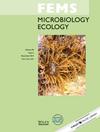感染时间影响真核藻类-核细胞病毒细胞的发育
IF 3.2
3区 生物学
Q2 MICROBIOLOGY
引用次数: 0
摘要
Aureococcus anophagefferens 与 "巨型病毒 "Kratosvirus quantuckense 形成了一个模型宿主-病毒系统。需要对其核糖体(未感染)和病毒细胞(病毒感染)形式进行研究,因为这些状态在藻类大量繁殖时会同时出现。此前,人们注意到光源能量、病毒颗粒生成和病毒细胞形成之间存在联系。我们探讨了一天中病毒与宿主接触的时间(上午、中午或傍晚)如何影响病毒细胞的形成。与此同时,我们还通过抑制光系统 II 探索了这种混养浮游生物对光源性能量的依赖性,测试了异养能量在感染动态中的作用。我们利用流式细胞术和光化学评估,检查了受感染细胞和对照组的生理机能,并估算了病毒粒子的产量。我们观察到核糖体细胞和病毒细胞对处理的反应存在差异,包括在光照减少(即持续时间)和 PSII 抑制(即 "强迫异养")期间病毒粒子产量的减少。这项工作证明了光照在影响受感染细胞命运方面的重要性,并提供了对制约原位藻华的因素的见解。最重要的是,我们发现病毒与宿主接触的太阳日时间会影响病毒粒子的产生,进而影响水华动态;这是水华建模工作需要考虑的一个因素。本文章由计算机程序翻译,如有差异,请以英文原文为准。
Time of day of infection shapes development of a eukaryotic algal-Nucleocytoviricota virocell
Aureococcus anophagefferens forms a model host-virus system with the “giant virus” Kratosvirus quantuckense. Studies to define its ribocell (uninfected) and virocell (virus-infected) forms are needed as these states co-occur during algal blooms. Previously, a link between light-derived energy, virus particle production and virocell formation was noted. We explored how the time of day (morning, midday, or late day) of virus-host contact shaped virocell ontogeny. In parallel, we explored the dependence on light-derived energy in this mixotrophic plankter by inhibiting photosystem II, testing the role of heterotrophic energy in infection dynamics. Using flow cytometry and photochemical assessments, we examined the physiology of infected cells and controls, and estimated virus particle production. We observed differences between ribocell and virocell response to treatments, including reductions in virus particle production during reduced light (i.e., duration) and PSII inhibition (i.e., “forced heterotrophy”) . This work demonstrates the importance of light in shaping the fate of infected cells and provides insight into factors that constrain in situ blooms. Most significantly, we show that time of the solar day when a virus and host come into contact influences viral particle production, and therefore bloom dynamics; a factor that needs to be considered in bloom modeling work.
求助全文
通过发布文献求助,成功后即可免费获取论文全文。
去求助
来源期刊

FEMS microbiology ecology
生物-微生物学
CiteScore
7.50
自引率
2.40%
发文量
132
审稿时长
3 months
期刊介绍:
FEMS Microbiology Ecology aims to ensure efficient publication of high-quality papers that are original and provide a significant contribution to the understanding of microbial ecology. The journal contains Research Articles and MiniReviews on fundamental aspects of the ecology of microorganisms in natural soil, aquatic and atmospheric habitats, including extreme environments, and in artificial or managed environments. Research papers on pure cultures and in the areas of plant pathology and medical, food or veterinary microbiology will be published where they provide valuable generic information on microbial ecology. Papers can deal with culturable and non-culturable forms of any type of microorganism: bacteria, archaea, filamentous fungi, yeasts, protozoa, cyanobacteria, algae or viruses. In addition, the journal will publish Perspectives, Current Opinion and Controversy Articles, Commentaries and Letters to the Editor on topical issues in microbial ecology.
- Application of ecological theory to microbial ecology
- Interactions and signalling between microorganisms and with plants and animals
- Interactions between microorganisms and their physicochemical enviornment
- Microbial aspects of biogeochemical cycles and processes
- Microbial community ecology
- Phylogenetic and functional diversity of microbial communities
- Evolutionary biology of microorganisms
 求助内容:
求助内容: 应助结果提醒方式:
应助结果提醒方式:


